2. 中国科学院空间科学与应用研究中心空间天气学国家重点实验室, 北京 100080
2. State Key Laboratory of Space Weather, Center for Space Science and Applied Research, Chinese Academy of Sciences, Beijing 100080, China
当IMF较长时间北向时, 地球磁层进入“安静”状态, 磁尾等离子片由“热而稀薄”变得“冷而致密”, 粒子的来源是太阳风和低纬边界层(LLBL, Low Latitude Boundary Layer)[1-4].一般认为, IMF北向时磁层顶重联应发生在极隙区附近[5-7], 这一重联对低纬边界层形成以及太阳风粒子注入磁尾等离子片起到关键的作用[8-10].
在Song和Russell的模型[8]中, 一条IMF磁力线分别与极隙区附近南北尾瓣的地球磁场重联, 从而形成新的闭合磁力线, 新的闭合磁力线沿磁层顶尾向扩展而形成LLBL.在IMF时钟角较小时(|Bz|>|By|), 有观测结果支持这一模型[10].图 1是Song和Russell的重联示意图.
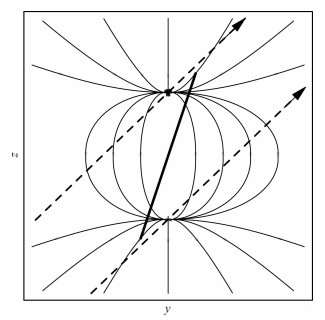
|
图 1 IMF北向时Song和Russell的重联模型 Fig. 1 Reconnecting pattern suggested by Song and Russell under northward IMF condition |
图 1中的粗实线表示IMF分别与南北极隙区尾瓣磁场重联后形成的新的闭合磁力线.按图 1所示, 这种重联只有当IMF接近纯北向时才有可能发生.图 1中虚线是我们添加的具有较大时钟角的IMF.可以看出IMF时钟角较大时, 可能在北(南)极隙附近与地磁场重联的IMF磁力线, 已经远离了另一侧极隙区.
在IMF时钟角较大时, 一般认为IMF会在向阳面先与北(南)半球的地磁场重联, 重联后一端在太阳风中一端与地球相连的磁力线运动到磁尾后, 再与南(北)尾瓣的地球磁场重联, 从而形成LLBL, 并完成磁力线循环[11-12].
过去对IMF北向时重联的研究重点在IMF Bz占主导(|Bz|>|By|)或基本上纯北向的情况[13-14].然而根据Parker[15]理论, IMF具有较大By分量的情形更具有普遍意义.在我们之前的工作中, 已经对IMF北向并且有较大By分量时(时钟角为60°), 磁层顶重联可能发生的位置及全球磁力线循环图像进行了研究, 但结果主要以二维投影的方式画出, 难以揭示重联的三维特征[16].本文的目的是对这一工作进行推进, 从而建立一个三维全球的重联和磁力线循环的图像.
2 模型简介本文模拟工作所采用的全球MHD模型较为详细的描述可参见我们以前的工作[17-19].模型基础为理想的MHD方程, 但由于数值效应的存在, 所以与扩散、阻尼相关的磁重联可以发生.模型为迎风差分格式, 并采用了可变格点与时间步长的技术, 有比较高的稳定性和计算效率.
模拟边界:日向56RE(地球半径), 尾向220RE, 垂直日地连线±132RE.日向边界采用太阳风输入条件, 其它外边界采用自由边界条件(等离子体参数法向分量为零).内边界在距地球中心2.8RE处, 内边界条件采用Reader的方法处理[20-21], 即在边界上通过磁力线映射的方法, 以场向电流为输入条件求解电离层电势的泊松方程:

数据结构:模型采用迎风格式差分, 坐标系采用GSE(地心太阳黄道系, Geocentric Solar Ecliptic coordinate).不同区域根据CFL(Courant-Friedrichs-Lewy)条件可以有不同的时间步长, 每隔0.6秒同步一次(这种方法可能会引起微小误差, 但计算效率大为提高).格点大小也可以根据需要改变, 可达到比较高的精度, 但为了兼顾计算效率, 本文工作采用了0.25RE(16RE以内及等离子片附近)-0.5RE(40RE以内)-2RE(远磁尾)的格点尺度分布.
初始条件:初始时刻地磁场为偶极场, 其中粒子初始密度n=1/cm3, 温度T=1 eV.太阳风速450km/s, 等离子体密度5/cm3, 温度10eV.IMF大小为5nT, 指向昏侧, 时钟角为60°(Bz=2.5nT, By≈4.3nT, Bx=0).为简单起见, 本文令磁偶极轴与GSE坐标系z轴重合.
3 结果与分析太阳风输入3~4个小时后, 磁层进入准稳态. 图 2是北极隙区附近昼夜子午面内的剖面图, 细线为磁力线投影, 不同颜色表示粒子密度.
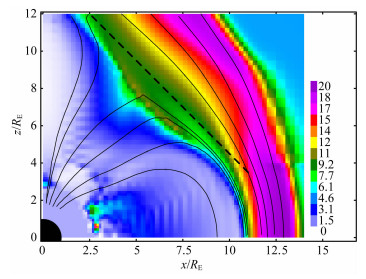
|
图 2 北极隙区附近昼夜子午面剖面(y=0) Fig. 2 Cross section of day-night meridian near the north cusp |
为了确定重联点的准确位置, 我们沿图 2中所示虚线并与纸面垂直的平面, 把虚线两侧的磁力线投影到该平面上, 如图 3所示.图 3中黑色粗线是地球一侧磁力线投影, 红色细线是太阳风一侧磁力线投影.
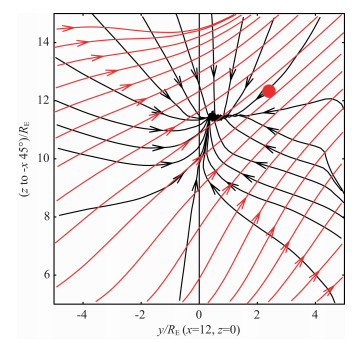
|
图 3 垂直北极隙区平面上的磁力线投影 Fig. 3 Projection of field lines on the plane perpendicular to north cusp |
从图 3中可以清楚看到IMF与地磁场反平行区的位置, 即最可能发生磁重联的地方.图 3中以红点标出.虽然IMF北向时, 磁层顶反平行重联与分量重联都有可能发生, 但在本文的模拟条件(正By和正Bz)下, 稳定持续的重联只发生在IMF与地磁场反平行的区域, 这与观测上反平行重联率远大于分量重联的结果是一致的[22].
根据模拟结果可以建立一个关于重联的全球的、三维的图像.图 4画出了IMF有60°时钟角时, 磁层顶重联的三维图像.图 4a是晨侧视图, 图 4b是昏侧视图.
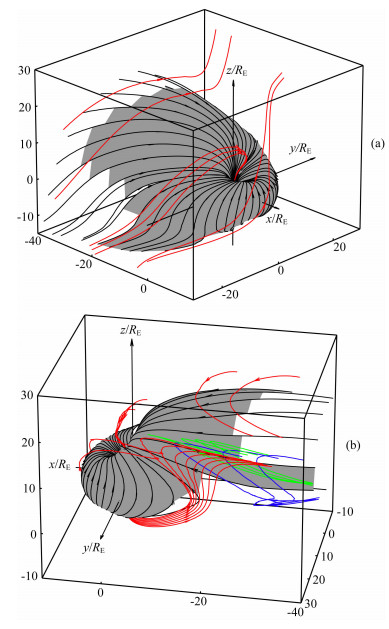
|
图 4 IMF北向(60°时钟角)时磁层顶重联三维示意图 (a)晨侧视图;(b)昏侧视图. Fig. 4 3-D reconnection patterns on the magnetopause under northward IMF with a clock angle of 60° (a) Viewed from dawn side; (b) Viewed from dusk side. |
按图 4a所示, 红线代表IMF及IMF与地磁场重联不久的磁力线.IMF与北极隙区的地磁场重联后分为晨昏两半, 晨侧的一端与极隙区地球磁场相连, 受到太阳风的拖曳, 由晨-北侧磁层顶尾向运动, 并逐渐成为北尾瓣开放磁力线.
按图 4b所示, 与IMF重联的地球磁场既有原来闭合的磁力线(图 4b中一端与南极隙区相连的红色线簇), 也有开放的北尾瓣磁力线(图 4b中绿色线条), 重联点实际位于磁层顶附近尾瓣开-闭磁力线的分界线上[23].另外, 我们也追踪到图 4b红色重联线尾向运动时还可能与北尾瓣开放磁力线二次重联, 从而在地球一侧形成新的闭合磁力线, 图 4b中蓝色线条是重联后脱离地球的磁力线(一端在太阳风中, 一端指向磁尾).这一过程将能形成LLBL, 并保证IMF与地球北-昏侧的闭合磁力线间的重联能持续下去.而IMF与北尾瓣开放磁力重联所造成的尾瓣开放磁力线损失, 则由晨侧运动过来的磁力线补充.图 4中所示的重联过程及磁力线循环, 不会显著增加或减少尾瓣开(闭)磁力线.
图 4b所示的磁层顶IMF与地磁场的二次重联发生在同一半球, 与以前的IMF分别在南北半球与地磁场重联并形成新的闭合磁力线的模型不一样[8, 11], 是一种新的重联与全球磁力线循环过程.这一过程应该在北向IMF并且时钟角较大时发生, 新的闭合磁力线从形成过程来看, 应该比IMF在不同半球发生的二次重联有更多的来自地球的高能粒子, 而LLBL又是磁尾等离子片的粒子来源[3], 所以这与观测上IMF Bz减小(北向IMF时钟角变大)而等离子片温度升高的结果是一致的[24].
以上都是北极隙区和北半球的情形.本文的工作中IMF没有Bx分量, 所以南半球的情况是完全类似的, 为简单起见没有再画出相关图像.
图 4a中所示重联后与北极隙区相联的磁力线尾向运动过程中将向晨侧拖曳, 这会使磁尾及等离子片产生逆时针(从地球方向看)旋转[25], 如图 5所示.图 5是x=-17RE处磁尾横断面粒子热压力分布, 单位为nPa, 箭头是横断面内流场分量(y、z分量)分布.
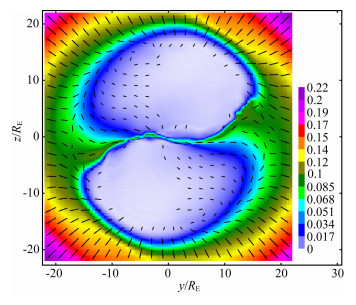
|
图 5 IMF北向时磁尾横截面粒子压力分布(x=-17RE) Fig. 5 Plasma pressure in the tail cross-section at x=-17RE(seen from the Earth) |
近磁尾沿尾向横截面逐渐变大, 所以横断面外侧流场指向外部.值得注意的是, 横断面内侧有分别起源于北-晨侧和南-昏侧指向等离子片内的粒子流存在.我们模拟中采用的是理想流体力学方程, 磁力线与粒子整体流是冻结在一起的, 故这种流场分布也反映了内磁层磁力线运动和循环路径.另外, 在我们采用的IMF条件下, 重联发生在北极隙区尾-昏和南极隙区尾-晨侧, 重联会不断剥蚀北-昏和南-晨侧磁层顶, 故图 5中相应磁层顶的边界比较薄且尖锐; 重联后的磁力线(如图 4a)不断附加到北-晨和南-昏侧磁层顶, 故相应磁层顶的边界存在比较宽的过渡区域.不同太阳风条件下, 磁尾特性及动力学过程将在我们以后的工作中详细讨论.
4 结论与讨论我们通过一个全球MHD模型研究了IMF北向时磁层顶重联发生的可能性, 并试图建立关于这一过程的全球性的三维图像, 结果发现:
(1)IMF具有正的Bz和By分量时(时钟角为60°)时, 磁层顶重联分别发生在北极隙区尾-昏侧和南极隙区尾-晨侧.重联后的磁力线分别在北南两极向晨昏侧拖曳, 从而使磁尾和等离子片产生S形旋转[26].
(2)IMF与地球磁场晨昏侧闭合磁力线及尾瓣开放磁力线都有可能发生重联, 即重联点位于磁层顶开放与闭合磁力线的分界线上.
(3)IMF在北(南)极隙区附近与地球磁层重联后, 与南(北)极隙区相连的磁力线在尾向运动过程中有可能与北(南)尾瓣开放磁力线再次重联而使磁力线重新闭合, 并形成LLBL.这种LLBL形成机制是IMF与同一半球的地磁场重联的结果, 与前人IMF在不同半球与地磁场二次重联的模型不同.
进一步研究表明, IMF北向时磁层顶重联点位于磁尾开放与闭合磁力线的分界线上的结果具有普__遍意义.由此可以做一个合理的推论, 即随着IMF时钟角的减小, 磁尾开放磁力线会逐渐减少, 直到纯北向时磁尾闭合[27-28].关于这一问题的详细研究将在以后的工作中进行.
磁层顶的重联将对内磁层特别是磁尾结构与物理过程产生非常重要的影响, 而磁层顶重联会受到太阳风变化及地球自转等因素的影响, 这些工作也将是我们进一步要研究的问题.
| [1] | Baumjohann W, Paschmann G, Gattell C A. Average plasma properties in the central plasma sheet. J. Geophys. Res. , 1989, 94(A6): 6597-6606. DOI:10.1029/JA094iA06p06597 |
| [2] | Terasawa T, Fujimoto M, Mukai T, et al. Solar wind control of density and temperature in the near-Earth plasma sheet: WIND-GEOTAIL collaboration. Geophys. Res. Lett. , 1997, 24(8): 935-938. DOI:10.1029/96GL04018 |
| [3] | Fujimoto M, Terasawa T, Mukai T, et al. Plasma entry from the flanks of the near-Earth magnetotail: Geotail observations. J. Geophys. Res. , 1998, 103(A3): 4391-4408. DOI:10.1029/97JA03340 |
| [4] | Fujimoto M, Mukai T, Matsuoka A, et al. Multi-point observations of cold-dense plasma sheet and its relation with tail-LLBL. Adv. Space Sci. , 2000, 25(7-8): 1607-1616. DOI:10.1016/S0273-1177(99)00674-2 |
| [5] | Kessel R L, Chen S H, Green J L, et al. Evidence of high-latitude reconnecting during northward IMF: Hawkeye observations. Geophys. Res. Lett. , 1996, 23(5): 583-586. DOI:10.1029/95GL03083 |
| [6] | Hasegawa H, Retinò A, Vaivads A, et al. Retreat and reformation of X-line during quasi-continuous tailward-of-the-cusp reconnection under northward IMF. Geophys. Res. Lett. , 2008, 35: L15104. DOI:10.1029/2008GL034767 |
| [7] | Taylor M G G T, Lavraud B, Escoubet C P, et al. The plasma sheet and boundary layers under northward IMF: A multi-point and multi-instrument perspective. Adv. Space Res. , 2008, 41(10): 1619-1629. DOI:10.1016/j.asr.2007.10.013 |
| [8] | Song P, Russell C T. Model of the formation of the low-latitude boundary layer for strongly northward interplanetary magnetic field. J. Geophys. Res. , 1992, 97(A2): 1411-1420. DOI:10.1029/91JA02377 |
| [9] | Li W H, Raeder J, Thomsen M F, et al. Solar wind plasma entry into the magnetosphere under northward IMF conditions. J. Geophys. Res. , 2008, 113: A04204. DOI:10.1029/2007JA012604 |
| [10] | Shi Q Q, Zong Q G, Zhang H, et al. Cluster observations of the entry layer equatorward of the cusp under northward interplanetary magnetic field. J. Geophys. Res. , 2009, 114: A12219. DOI:10.1029/2009JA014475 |
| [11] | Nishida A, Mukai T, Yamamoto T, et al. A unified model of the magnetotail convection in geomagnetically quiet and active times. J. Geophys. Res. , 1998, 103(A3): 4409-4418. DOI:10.1029/97JA01617 |
| [12] | Petrukovich A A, Baumjohann W, Nakamura R, et al. Plasma sheet structure during strongly northward IMF. J. Geophys. Res. , 2003, 108(A6): 1258. DOI:10.1029/2002JA009738 |
| [13] | Li W H, Raeder J, Dorelli J, et al. Plasma sheet formation during long period of northward IMF. Geophys. Res. Lett. , 2005, 32: L12S08. DOI:10.1029/2004GL021524 |
| [14] | Safránková J, Měrka J, Němecek Z. Plasma flow across the cusp-magnetosheath boundary under northward IMF. Adv. Space Res. , 2002, 30(12): 2787-2792. DOI:10.1016/S0273-1177(02)80412-4 |
| [15] | Parker E N. Dynamics of the interplanetary gas and magnetic fields. Astrophys. J. , 1958, 128: 664-676. DOI:10.1086/146579 |
| [16] | 郭九苓, 沈超, 刘振兴. IMF北向时磁层顶重联的模拟研究. 地球物理学进展 , 2013, 28(2): 540–544. Guo J L, Shen C, Liu Z X. Simulation of magnetic reconnection on the magnetopause under northward IMF condition. Progress in Geophysics (in Chinese) , 2013, 28(2): 540-544. |
| [17] | Guo J L, Liu Z X. Simulation of the dawn-dusk magnetosheath asymmetry under quasi-steady states. Chinese Sci. Bull. , 2005, 50(4): 341-346. DOI:10.1007/BF02897575 |
| [18] | 郭九苓, 王继业, 刘振兴. 不考虑磁层顶磁重联的全球三维MHD模型. 地球物理学报 , 2005, 48(1): 7–12. Guo J L, Wang J Y, Liu Z X. No magnetic reconnection at the magnetopause: A new 3D MHD simulation model. Chinese J. Geophys. (in Chinese) , 2005, 48(1): 7-12. |
| [19] | 郭九苓, 沈超, 刘振兴. IMF北向与南向时地球磁尾等离子片粒子注入机制. 科学通报 , 2012, 57(34): 3295–3300. Guo J L, Shen C, Liu Z X. Simulation and comparison of particle entering into the plasma sheet under north-and southward IMF conditions. Chinese Sci. Bull. (in Chinese) , 2012, 57(34): 3295-3300. DOI:10.1360/972012-447 |
| [20] | Raeder J, Vaisberg O, Smirnov V, et al. Reconnection driven lobe convection: Interball tail probe observations and global simulations. J. Atmos. Terr. Phys. , 2000, 62(10): 833-849. DOI:10.1016/S1364-6826(00)00041-9 |
| [21] | Raeder J, Mcpherron R L, Frank L A, et al. Global simulation of the Geospace Environment Modeling substorm challenge event. J. Geophys. Res. , 2001, 106(A1): 381-395. DOI:10.1029/2000JA000605 |
| [22] | Fuselier S A, Petrinec S M, Trattner K J. Antiparallel magnetic reconnection rates at the Earth's magnetopause. J. Geophys. Res. , 2010, 115: A10207. DOI:10.1029/2010JA015302 |
| [23] | Taguchi S, Hoffman R A. Ionospheric plasma convection in the midnight sector for northward interplanetary magnetic field. Journal of Geomagnetism and Geoelectricity , 1996, 48(5): 925-933. DOI:10.5636/jgg.48.925 |
| [24] | Tsyganenko N A, Mukai T. Tail plasma sheet models derived from Geotail particle data. J. Geophys. Res. , 2003, 108(A3): 1136. DOI:10.1029/2002JA009707 |
| [25] | Cowley S W H. Magnetospheric asymmetries associated with the y-component of the IMF. Planet. Space Sci. , 1981, 29(1): 79-96. DOI:10.1016/0032-0633(81)90141-0 |
| [26] | Kaymaz Z, Siscoe G L, Luhmann J G, et al. Interplanetary magnetic field control of magnetotail magnetic field geometry: IMP 8 observations. J. Geophys. Res. , 1994, 99(A6): 11113-11126. DOI:10.1029/94JA00300 |
| [27] | Elsen R K, Winglee R M. The average shape of the magnetopause: A comparison of three-dimensional global MHD and empirical models. J. Geophys. Res. , 1997, 102(A3): 4799-4819. DOI:10.1029/96JA03518 |
| [28] | Powell K G, Roe P L, Linde T J, et al. A solution-adaptive upwind scheme for ideal magnetohydrodynamics. J. Comput. Phys. , 1999, 154(2): 284-309. DOI:10.1006/jcph.1999.6299 |
 2013, Vol. 56
2013, Vol. 56

